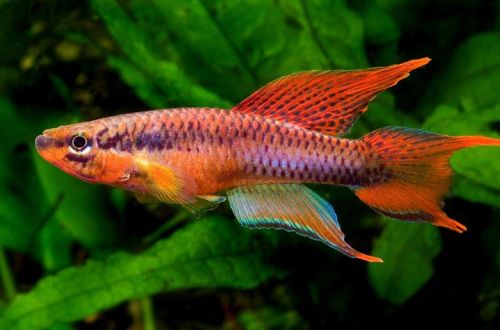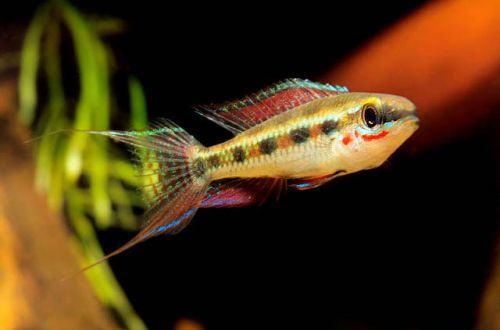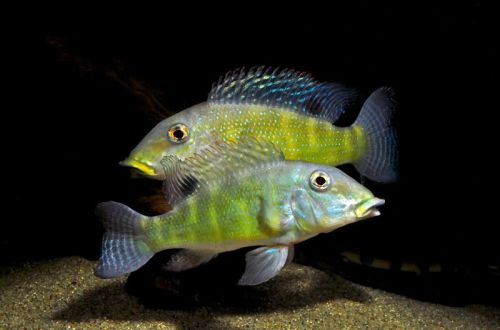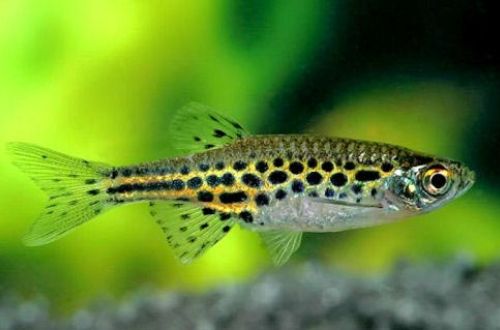
Afiosemion دو باند
Afiosemion two-lane, scientific name Aphyosemion bitaeniatum, belongs to the family Nothobranchiidae (Notobranchiaceae). Easy to keep bright fish. Can adapt to a wide range of conditions. The disadvantages include a short lifespan, which is usually 1-2 seasons.

فهرست
محل سکونت
Comes from equatorial Africa. It is widely distributed in the swampy coastal areas of Togo, Benin and Nigeria, as well as in the lower Niger river basin. Inhabits shallow streams, backwaters, lakes in the rainforest litter, in which the depth varies between 1–30 cm. Sometimes these are just temporary puddles. The bottom is covered with a layer of fallen leaves, branches and other plant organic matter. The water level in reservoirs is not stable, complete drying up is not uncommon.
اطلاعات مختصر:
- حجم آکواریوم - از 40 لیتر.
- دما - 20-24 درجه سانتیگراد
- مقدار pH - 5.0-6.5
- سختی آب - نرم (1-6 dGH)
- نوع بستر - هر
- نورپردازی - کم رنگ
- آب شور - نه
- حرکت آب - کم یا بدون
- اندازه ماهی 4-5 سانتی متر است.
- وعده های غذایی - هر وعده غذایی غنی از پروتئین
- خلق و خوی - صلح آمیز
- محتوا در یک گروه حداقل 4 تا 5 نفره
توضیحات:
Adults reach a length of 4-5 cm. Males look more colorful than females and have enlarged anal, dorsal and caudal fins, painted in red with turquoise edges, and with a pattern of small specks. Two dark stripes run along the body, stretching from head to tail. There is a variety called “Lagos red”, characterized by a predominance of red.
Females are noticeably more modest. The fins are short and translucent. The color of the body is gray-silver. Like males, they have a pattern on the body of two stripes.
غذا
The basis of the diet should be live or frozen food, such as bloodworms, daphnia, brine shrimp, mosquito larvae, fruit flies, etc. Can be accustomed to dry food, provided that they are rich in protein.
نگهداری و مراقبت، چیدمان آکواریوم
In nature, two-banded Afiosemione live in conditions that will be extreme for many fish. Such adaptability predetermined rather low requirements for the care of these fish species. They can be kept in small aquariums from 20-40 liters. The water temperature should not exceed 24°C. They prefer soft, acidic water, but also tolerate higher dGH values. The tank should be covered with a lid or only half full, this will prevent the fish from jumping out. In their natural environment, by jumping, they move from one body of water / puddle to another when drying occurs. In the design, it is recommended to use a large number of floating and rooting plants, as well as a layer of leaves. You can find out which leaves can be used in an aquarium in a separate article. The lighting is subdued. Any substrate, but if breeding is planned, then it is worth using special fibrous materials, thickets of small-leaved mosses, etc.
رفتار و سازگاری
Usually, Killy fish are kept in species aquariums. However, it is acceptable to be in the company of other miniature peace-loving species. Males of Afiosemion biband differ in territorial behavior and compete with each other. In small aquariums, it is worth buying a group with one male and several females.
پرورش / پرورش
If the fish live in a common aquarium, then it is advisable to breed in a separate tank. Optimum conditions are achieved in soft (up to 6 dGH) slightly acidic (about 6.5 pH) water at a temperature of 22–24 C°. Feed foods with a high protein content, or exclusively live foods. Eggs are laid in a dense layer of moss or a special spawning substrate. Caviar matures in 12-14 days. The fry that have appeared should also be planted in a separate container with identical water parameters. In the first 2–3 weeks, water filtration should be avoided, otherwise there is a high risk of juveniles getting into the filter. Water is partially replaced with fresh water once a week and uneaten food residues are removed in a timely manner to prevent excessive contamination.
بیماری های ماهی
شرایط زندگی مناسب احتمال شیوع بیماری را به حداقل می رساند. تهدید استفاده از غذای زنده است که اغلب حامل انگل است، اما مصونیت ماهی های سالم با موفقیت در برابر آنها مقاومت می کند. در قسمت بیماری های ماهی آکواریومی در مورد علائم و درمان بیشتر بخوانید.





